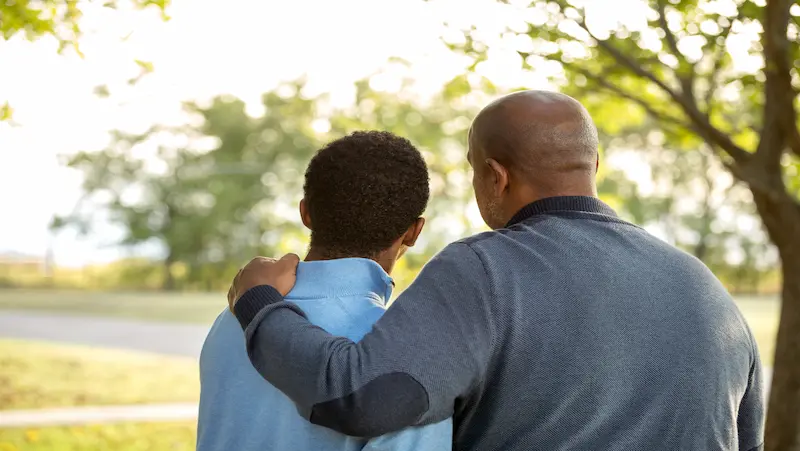We’re glad you found your way to our blog, where you’ll find helpful information on how to communicate effectively with teenagers. Strong relationships and an understanding of kids’ needs and concerns can only be built through open and honest dialogue. This guide will help parents overcome common obstacles and enhance their ability to communicate with their children.
Table of contents
Understanding Teenage Communication Patterns

Teenagers’ conversations are typically distinguished by a unique blend of intensity of feeling, curiosity, and openness to self-expression. Their communication patterns are heavily influenced by their peers, as they look to them for approval and affirmation. Knowing the effects of technological and social media advancements is crucial in today’s world. Teens can best be engaged through active listening and empathy.
1.Emotional Intensity
Emotions tend to be more intense during adolescence. It’s possible they’ll have intense responses and verbalise their emotions forcefully. Parents should listen to their teens and accept their feelings, providing a welcoming space where they can talk freely.
2.Exploration and Self-Expression
Teenagers can learn about themselves and develop their identities through the channels of communication. They may try out new methods of expression, including the use of slang and other nonstandard varieties of the English language. Providing a safe space for kids to explore their identities and develop their unique voices is crucial.
3.Peer Influence
Teenagers’ conversational habits are greatly influenced by their contemporaries. Teenagers’ communication preferences may be influenced by their need for social approval. To blend in with the crowd, they may start using the lingo, acting a certain way, or talking a certain way. To better comprehend their adolescent’s social connections, parents should keep the lines of communication open and be cognizant of the impact of peer dynamics.
4.Influence of Technology and Social Media
Teenagers’ modes of interaction are significantly influenced by the prevalence of technological and social media tools. For today’s youth, electronic means of communication such as texting, social networking, and instant messaging have become the norm. Parents need to be well-versed in these technologies, aware of how they affect their children’s communication patterns, and willing to set reasonable limits and rules for their kids’ use.
5.Active Listening and Empathy
Teenagers’ modes of interaction are significantly influenced by the prevalence of technological and social media tools. For today’s youth, electronic means of communication such as texting, social networking, and instant messaging have become the norm. Parents need to be well-versed in these technologies, aware of how they affect their children’s communication patterns, and willing to set reasonable limits and rules for their kids’ use.
Know more about best robotics for kids here
Overcoming Communication Barriers

The generational gap and the resulting differences in outlook between adults and teenagers can create communication difficulties. The only way to close the gap is by mutual comprehension and agreement. Understanding the feelings and thoughts that behind someone’s speech is greatly aided by picking up on nonverbal signs.
1.Generation Gap
The generation gap describes the disparity between what adults and young people think, feel, and have done. Because of these distinctions, it may be difficult for adults to effectively communicate with adolescents. An open mind, respect, and a willingness to learn from one another can go a long way towards bridging this gap. An increase in empathy and the discovery of shared interests can help bring people together.
2.Differing Perspectives
Teenagers and adults typically view social concerns, romantic partnerships, and lifestyle decisions from contrasting vantage points. These divergent points of view increase the potential for miscommunication and argument. To get past this impasse, people need to listen attentively to one another, try to comprehend the logic behind opposing viewpoints, and look for common ground. It calls for a mindset that is open to new ideas and isn’t closed to the possibility of being wrong.
3.Establishing Common Ground
Having something in common to talk about is essential. Bringing parents and teenagers together over things they enjoy doing together is a great way to build rapport and mutual understanding. Parents can ease into more difficult or sensitive issues by starting conversations with their children around these common interests. Finding shared interests and values can help parents and teens connect on a deeper level.
4.Recognizing Nonverbal Cues
Body language, facial gestures, and tone of voice are all forms of nonverbal communication that contribute greatly to conversation. By paying close attention to these hints, you can better grasp the motivations and ideas driving a teen’s words and actions. Parents can learn more about their adolescent’s emotional state and respond with more empathy and understanding if they take the time to pay attention to and make sense of their nonverbal signs. This improves communication because it increases understanding and lessens room for misunderstanding.
Building Trust and Respect

Effective communication with teenagers is built on a bedrock of mutual trust and respect. Parents can win their children’s trust by consistently delivering on their commitments and protecting their privacy. When others feel safe to be themselves around you, they are more likely to speak freely and openly. Teens can feel safe sharing their thoughts and feelings in a judgement-free zone.
1.Be Reliable
To be trustworthy, one must continually display dependability. If you make a promise to an adolescent, make sure you keep it. Being trustworthy demonstrates that you can be relied on and that what you say has merit. This dependability fosters confidence in the long run.
2.Maintain Confidentiality
Trust can only be established by treating a teen with respect and keeping their information private. This means not disclosing their identity, thoughts, or feelings without their express consent. When you don’t cross any of their personal boundaries or betray their confidence, they feel more at ease opening out to you.
3.Respect Privacy and Individuality
Admit that teenagers require more privacy and independence. Allow them to be alone with their own thoughts, beliefs, and experiences without interfering with their privacy. A lack of trust and difficulty communicating might be caused by being too controlling or overly intrusive.
4.Create a Non-Judgmental Atmosphere
Teens are more likely to speak freely when they know they will not be judged. Don’t judge them based on their decisions, values, or life experiences. Instead, offer them a supportive environment where they may air their grievances without worrying about being labelled or ridiculed. Create an atmosphere of acceptance and understanding by listening attentively, validating their emotions, and providing encouragement.
Effective Communication Strategies

Positive reinforcement and attentive listening can do wonders for parent-teen communication. Parents can show their kids they care by listening carefully and responding appropriately when their kids express emotion. Meaningful interactions can be fostered through the use of good questioning tactics. Misunderstandings can be avoided if communication is clear and succinct, and delivery is improved by adjusting one’s body language and tone of voice to fit the content being sent.
1.Active Listening and Validation
Teenagers appreciate it when adults pay attention to them and demonstrate they have interest in what they have to say by engaging in “active listening.” It entails not interrupting the speaker, paying attention to what they’re saying, and trying to put yourself in their shoes. Having their emotions and experiences validated demonstrates empathy and lets them know they are heard and understood. By recognising the other person’s feelings and listening attentively, you foster an atmosphere where open dialogue is encouraged.
2.Effective Questioning Techniques
Teens can be helped to open up and have meaningful interactions by using open-ended questions. They are more likely to elaborate in response to open-ended queries, leading to a more in-depth discussion. Asking clarifying questions helps to ensure that your understanding of their position is complete and accurate. If you want to communicate with a teen effectively, you should avoid asking them leading or judgmental questions.
3.Clear and Concise Communication
Effective communication with teenagers relies on clear and precise speech. Communicate your ideas and requirements clearly and directly, using language at their comprehension level. Don’t use jargon or other terms they might not understand. It is helpful to check for understanding by having the other person explain or repeat what you just said.
4. Matching Body Language and Tone of Voice
Body language and vocal inflection are only two examples of the many nonverbal indicators that contribute to effective communication. Maintaining steady eye contact and a relaxed yet alert posture will convey friendliness and openness. It’s crucial to use a tone of voice that fits the content of what you’re saying; a friendly, courteous tone creates an inviting space for conversation. You may improve the impact of your message and the quality of your communication as a whole by paying attention to your nonverbal clues and making sure they match the words you use.
Conflict Resolution and Problem-Solving

Disagreements and conflicts may arise; the key is to learn to deal with them in a positive way. Recognising and processing feelings during disagreement is crucial to finding solutions. Parents may equip their teens to develop win-win solutions by instructing them in problem-solving skills. The ability to communicate and resolve conflicts effectively is aided by teaching people to compromise and negotiate.
1.Understanding and Acknowledging Emotions
Emotions often run high during conflicts, making it all the more important to recognise and comprehend them. Teens should be encouraged to freely share their thoughts and feelings. When you validate someone’s emotions, you open the door to honest communication and, ultimately, conflict resolution.
2.Teaching Problem-Solving Techniques
Help young people develop the problem-solving skills they’ll need to handle disagreements maturely. Instruct them to zero in on the central problem, generate a list of possible solutions, and weigh the benefits and drawbacks of each. Inspire analysis and innovation to develop solutions that work for everyone.
3.Promoting Compromise and Negotiation Skills
Drive home the value of giving and taking as dispute resolution tools. Encourage young people to take into account the feelings and viewpoints of those around them. Encourage productive bargaining by instructing them in the art of good communication, including such skills as active listening and aggressive need expression.
4.Healthy Communication and Conflict Resolution
Stress the importance of keeping lines of communication open and healthy even as tensions rise. Get your teen to avoid accusations and blame by having them express themselves in “I” statements. Encourage empathetic active listening, in which each party makes an effort to understand the other’s point of view.
Nurturing Emotional Intelligence

Teenagers rely heavily on their emotional intelligence when interacting with others. Emotional intelligence in adolescents can be fostered by parental encouragement of introspection, self-awareness, and emotional management. Teenagers can better manage their feelings and communicate with the world around them if they are exposed to and encouraged to develop empathy.
1.Encouraging Self-Reflection
Teens might benefit from engaging in self-reflection by thinking about and talking about how they feel and what they do in various situations. Assist them in coming to terms with who they are and what they value. Teens can greatly benefit from developing their communication skills by engaging in regular self-reflection to acquire insights into their emotions and increase self-awareness.
2.Developing Emotional Awareness
Encourage young adults to reflect on and comprehend their own and others’ feelings. Help them develop a proper vocabulary for describing their feelings. Adolescents can improve their communication and interpersonal skills as well as their ability to empathise with others if they take the time to build their emotional awareness.
3.Cultivating Self-Regulation
Help young adults develop appropriate strategies for controlling their impulses and dealing with their feelings. Help them learn to manage their impulses, put off gratification, and keep their cool. Teens can improve their ability to relate positively and productively with others by practising self-regulation skills.
4.Understanding the Benefits of Empathy
Teach your adolescent the value of empathising with others by encouraging them to consider the feelings and viewpoints of those who are different from themselves. Encourage children to think like other people by asking them to imagine what it would be like to be in their position. By learning the value of empathy, people can improve their ability to connect with others and have more fruitful conversations.
Explore about coding school for kids here
Conclusion
Understanding how to effectively communicate with a teen is a skill that must be honed over time. By putting into practice the advice given in this blog, parents can improve their relationships with their teenagers and provide the groundwork for a lifetime of mutual respect and trust. Improving relationships, gaining mutual respect, and learning more about a teen’s needs and goals are just a few of the long-term benefits of having open lines of communication. Adopt these methods, and you’ll be well on your way to a fruitful dialogue with your adolescent.
Also, BrightChamps provides a comprehensive platform for learning about money for kids, offering interactive and engaging resources that teach financial literacy, budgeting, saving, and other essential money management skills.
Frequently Asked Questions(FAQ’s)
A1: Effective communication is crucial during the teenage years as it helps build strong relationships, fosters understanding, and promotes healthy development. It allows parents to connect with their teenagers, address their needs and concerns, and support their emotional well-being. Effective communication also helps teenagers develop their own communication skills, express themselves, and navigate challenges they may face during this critical stage of life.
A2: Establishing open lines of communication with your teenager involves creating a safe and non-judgmental environment. Actively listen to them, show empathy, and respect their opinions. Encourage regular conversations, set aside dedicated time for quality interactions, and be approachable. Additionally, be open and honest in your own communication, which encourages them to do the same.
A3: Common communication challenges include generation gap, differing perspectives, and misunderstandings due to misinterpretation of words or nonverbal cues. Teenagers may also struggle with expressing their thoughts and emotions, while parents may find it challenging to balance guidance and autonomy. These challenges can be overcome through active listening, empathy, and finding common ground.
A4: To improve active listening, give your full attention, maintain eye contact, and be genuinely interested in what your teenager is saying. Avoid interrupting or jumping to conclusions. Practise reflective listening by paraphrasing their thoughts and feelings to show understanding. Ask open-ended questions to encourage deeper conversations and clarify understanding.
A5: Navigating conflicts and disagreements with your teenager requires active listening, respect, and empathy. Create a safe space for open dialogue, allow them to express their perspective without judgement, and validate their emotions. Focus on problem-solving rather than blaming or criticising. Strive for compromise and mutual understanding, maintaining a respectful and loving connection throughout the process.
A6: Non-verbal communication, including body language, facial expressions, and tone of voice, plays a significant role in teenage communication. It provides additional cues about emotions, attitudes, and intentions behind the words spoken. Being aware of and interpreting non-verbal cues enhances understanding, helps convey empathy, and ensures alignment between verbal and non-verbal messages.
A7: Encouraging open expression requires creating a safe and non-judgmental environment. Be approachable and actively listen without interrupting or dismissing their thoughts. Validate their emotions and perspectives, showing understanding and empathy. Avoid reacting with criticism or judgement. Encourage their autonomy and allow them to share their thoughts and emotions at their own pace.
A8: Some communication techniques that work well with teenagers include active listening, using open-ended questions, and practising reflective listening. Encouraging their autonomy and respecting their opinions fosters open communication. Using positive reinforcement and acknowledging their efforts and achievements also helps create a supportive and constructive communication dynamic.
A9: When addressing sensitive topics, choose an appropriate time and place for the conversation. Approach the topic with sensitivity, empathy, and respect for their feelings and perspective. Be open to their reactions and allow them to express themselves. Use clear and non-judgmental language, and listen actively to their concerns. Focus on understanding and finding solutions together.
Q10: What are some ways to build trust and rapport with my teenager through communication?
A10: Building trust and rapport involves being reliable, keeping promises, and respecting their privacy and individuality. Maintain open and honest communication, actively listen, and show empathy. Create a non-judgmental atmosphere that encourages them to express themselves freely. Foster a sense of mutual respect and understanding, and consistently demonstrate your love and support.


 We are an army of educators and passionate learners from BrightChamps family, committed to providing free learning resources to kids, parents & students.
We are an army of educators and passionate learners from BrightChamps family, committed to providing free learning resources to kids, parents & students.







